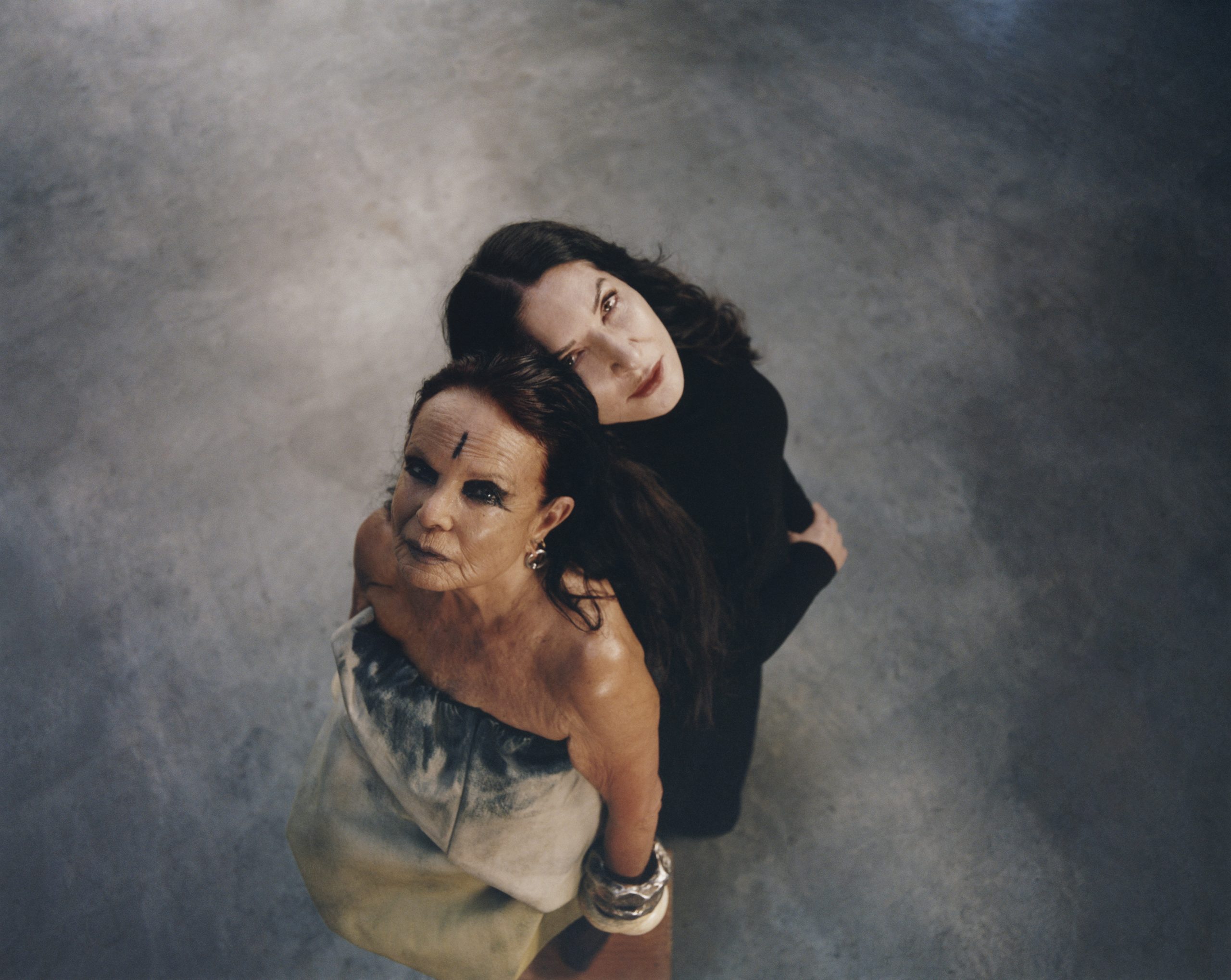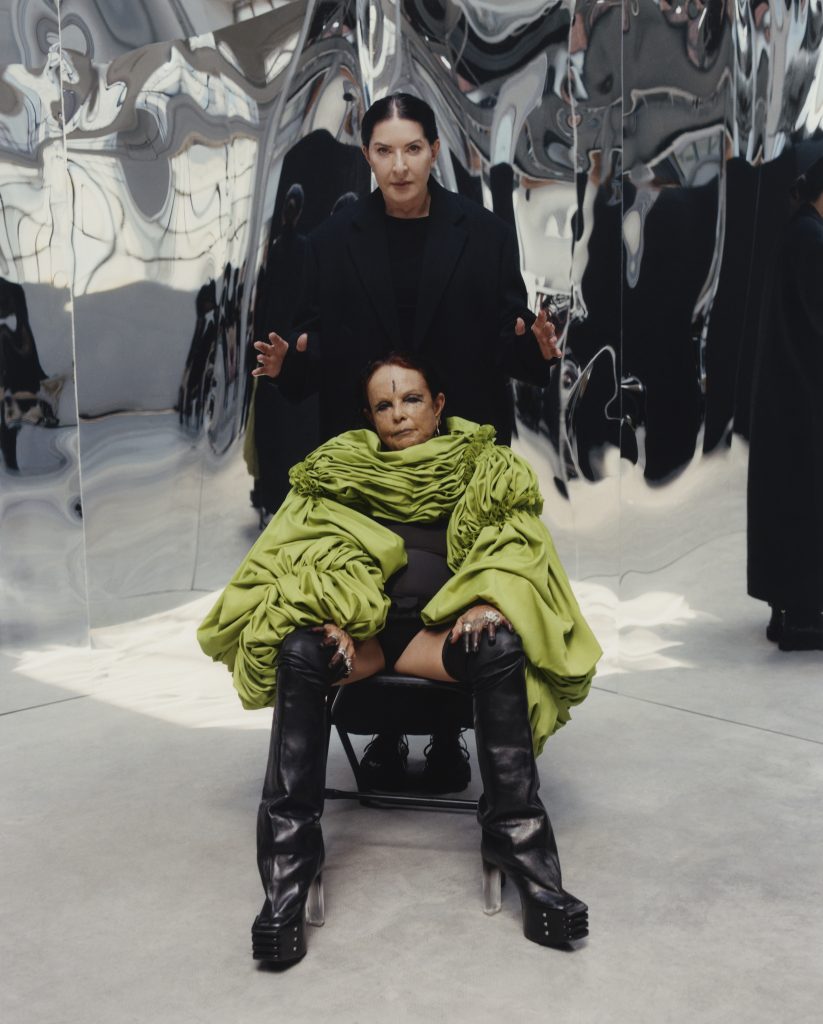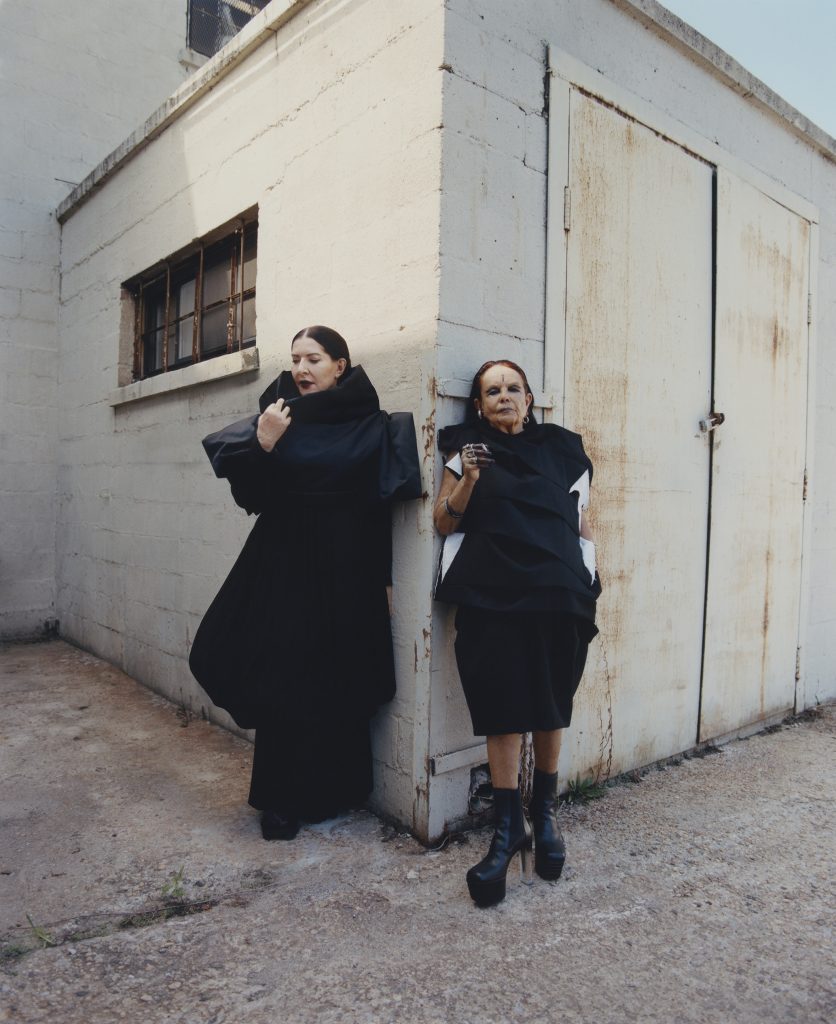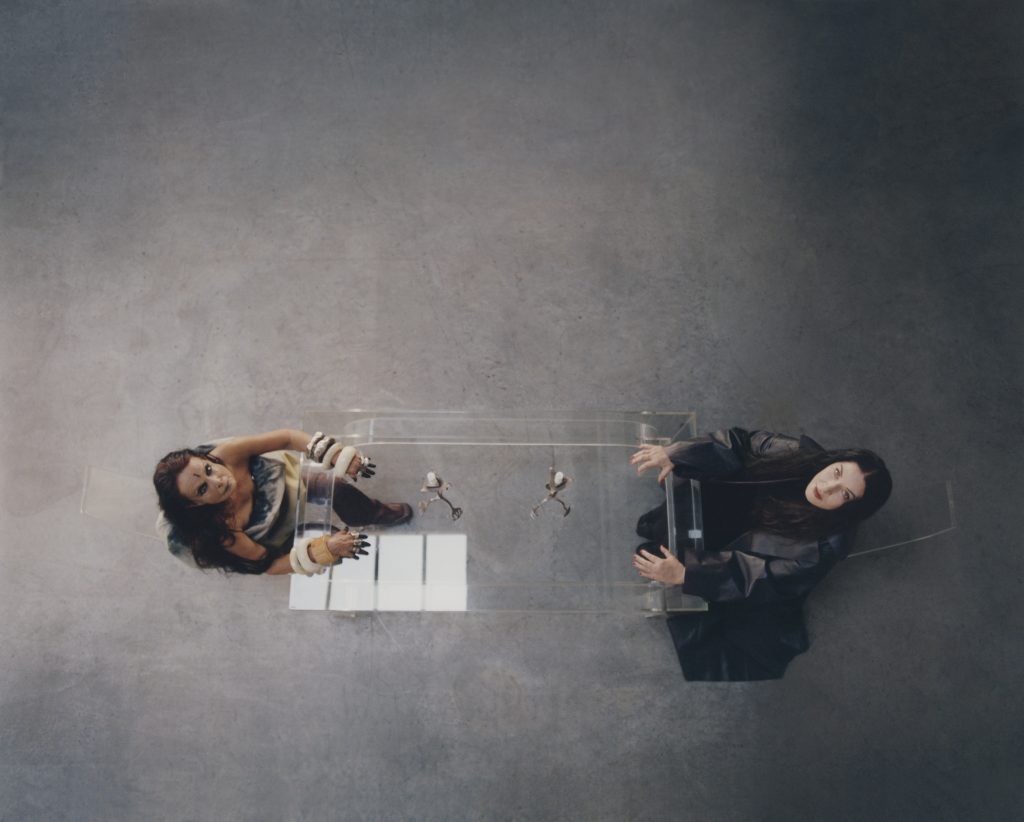Marina Abramović and Michèle Lamy
Roses are planted where thorns grow (William Blake)

hube: Art thrives where there is freedom. Artists should not be limited or constrained by political, ethical, or social frameworks. You’re both constantly reinventing the relationship between artist and society, pushing boundaries through your work, and challenging your audiences. Can you elaborate on this? Do you believe that every artist should somehow challenge societal and ethical norms?
Michèle Lamy: The thing is, Marina is an artist, but I am not really an artist.
Marina Abramović: Oh, but my dear, you are so many other things!
ML: And that’s the thing! To me, art is a form of expression; so, in that way, we are similar. I am not sure how to answer those questions, except to say that we are both expressing ourselves. Although I’m sure you, Marina, can answer this better than me. I think that artists need to be present, like when Marina was at MoMA. I don’t think an artist should be or do anything except express themselves.
MA: This is something I really would like to speak about with you, Michèle, I’m so interested to know your thoughts. But first let me say one thing, what is really important here… for every artist, as for every human, it’s important to know where you come from and what your background is. My background is pure communism. I’m from former-Yugoslavia: with Josip Broz Tito as our president, with parents who are national heroes and a Serbian Orthodox grandmother who hated communism and spent all her time in church.
As a child, I was a mixture of all of these different things, and a particularly important part of my upbringing was not being afraid of anybody or anything. This is number one. Number two: You need to sacrifice your private life and private comfort for a higher cause. That higher cause can be anything you believe in. It can be creativity, it can be the search for new ideas, it can be science or writing. Whatever it is, you shouldn’t lose the sense of freedom. It’s very important for an artist.
Looking back at the ’60s and ’70s, that sense of freedom was so much larger than it is today. Today, everything is politically correct. You can’t do this, and you can’t do that. Everything that happened in art in that time would not be possible today. I think political correctness is really killing creativity.
In my mind, I classify people into two categories: Originals and those who are following. That’s it. Originals are not only artists. Originals are all human beings who find their own way of expressing themselves. It’s so important. They are precious, the ones who are not afraid to be themselves.
You definitely fall into this category, originals. And this is why I’m so incredibly honoured and proud to be with you in this room today. You don’t need to be an artist or to be classified as an artist. Whatever you touch or create, you’re doing something that is so special and so different. This is who you are. I’m wondering, what is your background?
ML: I’d like to tell a story about my background that, in a sense, we have in common—although I am a few years older than you. My parents met in the resistance at the end of the war. My mother was bringing food to the rebels hiding in the woods, and that’s how she met my father. I was born shortly after. For the rest of it, I have just lived life taking any opportunities.
I’m not a surfer, but I have a feeling that everything in life is like those waves; always going up and down, it’s about following the flow. For example, I did a project for Circa [Cultural Institute of Radical Arts] a while ago where I posed naked in a video, staring at people. In a way, it reminded me of what you do. It was the same look of compassion toward the world. I’m currently working on a big event in November with The Skateroom guys to raise funds to build a skatepark in a refugee camp. Essentially, I have this thing where I like to create a world inside a world, where something leads to something else.
MA: Yes, but it is not only that. You organise the best events in Paris. You connect people with other people that they would never have otherwise met, and give them the benefit of knowing each other. You have this charisma and people are drawn to you. This is huge.
ML: Yes, this is what I meant, I am not an artist like you are. You are an artist in the current sense of the word. I am more like a rhizome; people see my iconic teeth and are drawn to me. And then, as soon as I see and meet new people… I don’t know what happens, I cannot explain it. These connections are created. I’m always searching for new energy, new beginnings. I always have to be doing something.
h: The human body has been an artistic subject for centuries, and it holds a crucial role in both of your artistic practices. Do you see it as a body or a curse?
ML: I mean, we have no choice but to embrace our bodies, which is why I struggle with this question.
MA: Yeah, absolutely. We don’t have a choice. We must accept it in order to live, we have to deal with it. This is why it’s so interesting to work with the body; to this day, we still don’t know much about it.
ML: I mean we know a few things [laughs].
MA: That’s true, [laughs] but not much! This is why working with the body is a process of continuous learning.
ML: Yes, and in a sense, you are the perfect example. You “tame” your body. You work with it and, especially as a performance artist, you use it to express yourself and don’t let it limit you. In the same way that I changed my teeth and put a titanium thing in my leg to walk without a femur. We express everything and live everything with the body.
MA: Essentially, we both agree: the body is definitely a blessing! Not a curse.





h: To seek truth you must confront delusion. Mistakes and failures are vital to creative development. Do you recall your mistakes? What role have they played in your creative practices?
MA: Oh, my favourite question. Ok kids, failure is so important. It’s essential. The more you fail, the better you are. You know that the amount of success you achieve in your life is commensurate to how many times you are willing to fail. If you always do things you like and things that you’re good at, you never change. You’re repeating the same pattern over and over again. But, if you go into a territory that you’re afraid of… a territory that you don’t know, a territory you’ve never been before… if you go into the unknown it will help you to grow.
This is like exploring, you know, like Columbus when he discovered America. He was going to discover India, but he found America instead. At that time, people believed that Earth was flat and that we could fall off it. It was incredibly brave to go somewhere when you thought you might fall off the Earth as a result. And then, oops, you “discover” America. You can’t do things like this without actually engaging with risk. Failure is part of success, an incredibly important part. My advice: always go into the unknown, to a place where you can fail.
ML: Exactly. Perhaps I’ve been lucky, because I haven’t had a failure that was really catastrophic, but I do think failures help build your strength. They build your own spirit, and help you create your own path. If you fail, you need to turn around and do it better next time. Don’t avoid failure on purpose. As you said, failure is essential.
We live within our own performances. I think performing is the most gutsy thing you can do. It can be scary, but the scariest shit is to give up. It’s so important not to give up and feel that you have made a mistake. Say you burn the toast, or whatever. It doesn’t mean you are never going to eat again after that. It’s the same in life, you know.
MA: I think there is not enough humour and there is not enough play. People are not playing anymore. Remember Dada, the surrealists, [Francis] Picabia? They had so much fun. I believe great art comes naturally; it is not forced.
Art has become a commodity. Today, everything has huge value ascribed to it. Before, people didn’t think that they could make money from art. Musicians were driving taxis and artists were working in bars. We had to create because we couldn’t do anything else, because creation felt like oxygen. But we didn’t think that we would make a living out of it.
Remember how Vivienne Westwood started? It was a play and we enjoyed it. It was such a different attitude compared to today.
ML: Yeah, now we’re all on Instagram everybody wants to be famous in five minutes.
MA: Young artists, don’t come to me and say: “I want to be rich and famous.” If you do, I will send you home. Art isn’t about being rich and famous. It is about creativity. You know what drives me crazy, that everything comes from counting. How many? How many African-American artists, how many white artists, how many queer artists, how many trans artists? We’re talking about numbers, but we are not talking about content and creativity.
ML: Exactly. Everything is divided now. Everybody thinks they are starting a revolution. I remember when I was 17 or 18, there were loads of new movements and thoughts flowing around in the art world, but we weren’t even really talking about it. Anyway, we don’t want to complain as old ladies usually do. But yeah, some things have changed, but we keep going.
MA: Michèle, you know what? You’re a true warrior. And I am pretty much a warrior too.
ML: You are!
MA: We are not just normal female humans.
ML: At the same time, we’re very optimistic.
h: Sometimes words are not enough. They’re almost neglected in fashion, for example, and it seems that you both have a spiritual relationship with this particular creative world. Do you think that nonverbal forms of expression—line, colour, gesture, shape—can be more truthful and explicit than words?
ML: Of course.
MA: I agree.
ML: However, some people are very good with words, and sometimes we don’t like what they say.
MA: Absolutely. In Tibet, there are different types of teaching. The most ordinary and the most common is when the teacher talks to his students, verbally passing on his knowledge with his words. The second way is when you only express your ideas with gestures. The third way is when the whole class is sitting in silence and the knowledge is transmitted with the teacher’s silence.
ML: It’s true. Sometimes we don’t need words at all.



Talent: MARINA ABRAMOVIĆ & MICHÈLE LAMY
Photographer: JOSHUA WOODS @ CLM
Stylist: GABRIELLA NORBERG
Makeup: ROMMY NAJOR @ FORWARD
Hair: AKIHISA YAMAGUCHI @ FORWARD
Manicurist: KEITH “PIKA” HOLMES
Set Designer: CAZ SLATTERY @ CLM
Producer: MARY GOUGHNOUR @ CLM
Photo Assistants: STEPHEN WORDIE, NICK GRENNON, ASHTON HERMAN
Stylist Assistant: PAU SAFRONCHIK
Makeup Assistant: NICO QUARANTINO
Junior Producer: CAROLINE WESTDYK @ CLM
Production Assistant: BABE LAWERENCE
Set Assistants: KALLIOPE PIERSOL, OSCAR ROMERO
With special thanks to the teams of RICK OWENS and MARINA ABRAMOVIĆ, alongside CLM, FORWARD, and 37VD STUDIO—without your support, this shoot wouldn’t have happened. And a huge thank you to JONATHAN OSOFSKY at KASURI in New York for his support on this project.
You’ve just finished reading an excerpt from an interview that featured in the third issue of hube magazine. Purchase a copy here to get the full experience.
